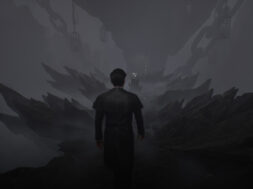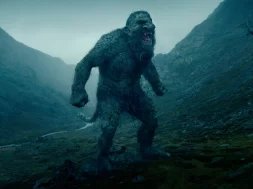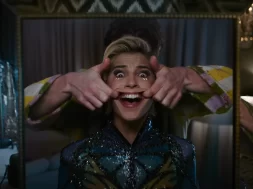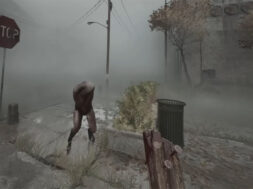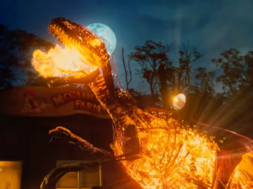![‘Sherlock Holmes: The Awakened’ Arrives April 11, Pre-orders Now Live [Trailer]](https://scaryoverload.com/wp-content/uploads/2023/03/sherlock.jpg)
The gaming community is one of the most vocal niches of the internet, so it makes sense that when a certain online trend is born, gamers are usually the first to interact with it. That’s why nearly every internet legend has its own videogame adaptation, with developers taking inspiration from bizarre creepypastas like The Backrooms and Sirenhead years ahead of Hollywood studios and network television.
Of course, the most famous of these internet-derived horror experiences is likely Mark J. Hadley’s freeware hit, Slender: The Eight Pages, a title that took the indie gaming scene by storm back in 2012. Adapting Victor Surge’s faceless creation into a Found-Footage-inspired gauntlet of lo-fi hide-and-seek, this short but sweet romp through spooky woods became infamous once online influencers began to challenge each other to endure these scares in exaggerated Let’s Play videos. At one point, Slender’s official website even crashed due to excessive downloads, making this one of the first viral freeware sensations since the days of Doom’s free demos.
And with The Eight Pages becoming a tremendous success, it’s only natural that Mark would move onto a decidedly non-freeware sequel, with his Parsec Productions partnering with Blue Isle Studios to create a much more ambitious title. Released in March of 2013,Slender: The Arrival was highly anticipated by gamers and online horror enthusiasts alike, and while it couldn’t possibly live up to the expectations of fans, I believe the title has aged well enough to still be worth discussing ten years down the line.
Like The Eight Pages, development of The Arrival focused heavily on exploring the established Slender Man lore. After all, the eldritch creature was the by-product of an international game of exquisite corpse, with countless individual blogs, web-series and short stories continually expanding the mythology behind the internet’s (then) favorite monster. This gave the devs quite a collection of spooky narratives to inspire their new game.

Slender Man isn’t the only one chasing you this time!
That’s why it makes sense that Mark would recruit the team behind Marble Hornets, the insanely successful web-series that helped to popularize Slender Man in the first place. The first game already had references to the series (even including a Marble Hornets Mode that made the experience feel like one of the Found Footage entries from the show’s YouTube channel), but the sequel’s script would actually be co-written by the MH creators. This resulted in a title that fit snuggly into the Slender Man canon unlike anything fans had ever seen before.
This time around, the story would follow the ill-fated Lauren as she searches for her missing sister Kate, who we later find out is the protagonist of the first game, only to fall into a rabbit hole regarding missing children and interdimensional entities. Along the way, Lauren is pursued by the elusive Slender Man himself as well as the masked “Chaser,” a brainwashed Slender Man follower inspired by Marble Hornets’ “Masky,” with the game eventually explaining the origins of the Eight Pages tape in a surprisingly compelling piece of interactive Found Footage.
Unfortunately for the developers, this attention to narrative detail couldn’t quite sway critics who believed that the title was a step down from the smaller-scale original. Sure, most outlets praised The Arrival’s story and genre presentation, but many gamers simply couldn’t get past the title’s reliance on repetition and shock value rather than sustained frights.
In fact, more than a few reviewers were put off by the game’s copious amount of jump scares, with many agreeing that the spooky moments inevitably became tiresome due to over-exposure despite the title’s disappointingly short campaign. Your only options when encountering enemies are to either flee or stun them with the flashlight, with the latter mechanic being an Alan-Wake-inspired band-aid on a recurring problem of limited interactivity. At the end of the day, the overall consensus was that the game felt like a walking simulator peppered with randomized jump scares.
It makes sense that developers hadn’t quite mastered the art of life-or-death hide-and-seek mechanics, as the closest thing to the Slender Games at the time were Frictional Games’ Amnesia and Penumbra titles, which also had players solving first-person puzzles while avoiding (mostly) unkillable pursuers. However, those titles benefited from more naturalistic gameplay flow by not relying on closed-off scare arenas, while player survival in Slender depended on trial and error and hidden RNG elements.

Nope, nope, nope!
That being said, it’s curious to note that the exact same elements which made The Eight Pages a runaway hit in 2012 were later considered glaring faults in the sequel. While a jump scare simulator seemed entertaining enough when it was free, a paid version was apparently asking too much of gamers, even if it came bundled with a legitimately thrilling story. I’d chalk this up to exaggerated expectations.
Of course, 10 years of running away from relentless pursuers like the mental patients from Outlast and the Xenomorph from Alien: Isolation have given us some more perspective on what gamers expect from a horror title. Despite some mechanical blemishes, it’s pretty clear now that The Arrival tapped into some innovative scares that few modern titles have been able to replicate, it just wasn’t able to perfect these ideas at the time.
Sure, it’s not exactly a very replayable experience (unless you count the level that remakes the original game in glorious HD), but the ambience and rising tension here are impeccable, especially when you consider the limited budget. The analogue visual elements are also a huge atmospheric bonus, making it much scarier when you finally encounter the faceless fiend himself. Hell, the sequence where you have to try and close all the windows in the house in order to keep Slender Man at bay remains a masterclass in building horrific anticipation, and that forest fire climax is still incredibly thrilling even in 2023.
While I agree with most critics when they say that the game could have mixed things up with added mechanics and more varied levels, I believe that time has been kind to The Arrival. In fact, I’d even argue that the game’s short length and focus on narrative makes it a prime choice to re-install on a rainy evening and play the whole thing at once as if you were watching a movie – especially if you’re a fan of late 2000s internet horror.
It’s certainly no masterpiece, but this is undoubtedly one of the best pieces of Slender Man media out there, not to mention a damn fine collection of unexpected jump scares.
